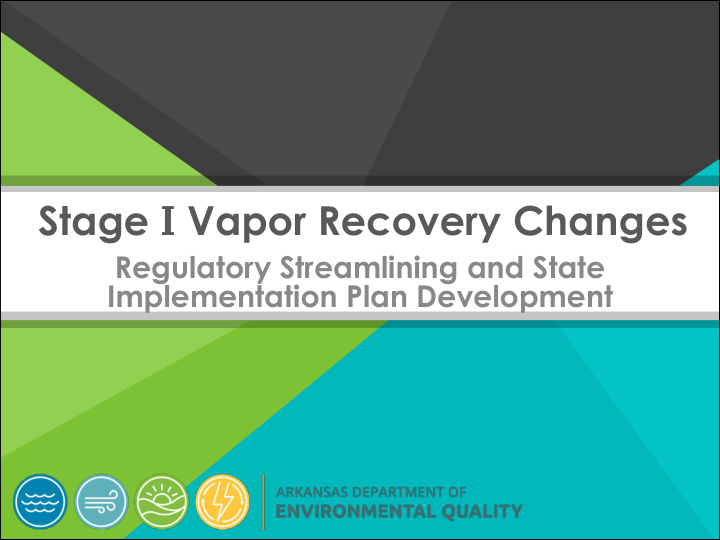



Stage I Vapor Recovery Changes Regulatory Streamlining and State Implementation Plan Development
Importance History Overview Changes
REGULATION HISTORY
• Adopted during 2004 • Applies only in nonattainment areas for ozone • Was actively enforced in Crittenden County upon adoption until 2010; and again between 2012 and 2016 • No current nonattainment areas within Arkansas 4
Crittenden County • 1997 Ozone NAAQS(80 ppb) Nonattainment Status 6/15/2004 – 4/23/2010 • 2008 Ozone NAAQS (75 ppb) Nonattainment Status 7/20/2012 – 6/03/2016 5
Crittenden County • Gradual rollout, with information disseminated through the Arkansas Oil Marketers Association (AOMA), and surveys performed to assess the compliance status of facilities in Crittenden County • Compliance inspections started in 2006, focusing on actually having a Stage I Vapor Recovery system, and progressed to maintenance and testing of the systems 6
Past Concerns of the Regulated Community Source: American Petroleum Institute (2014) Monitored CBSAs and rural counties that would be violating a 60 ppb standard Unmonitored areas that are anticipated to violate a 60 ppb standard based on spatial interpolation 7
REGULATION IMPORTANCE
Importance of Regulation Helps reduce VOCs, a precursor to the formation of Ozone, in nonattainment areas 9
Ozone Health Impacts: “Pyramid of Effects” At-Risk Groups Include: People with lung • disease, such as asthma or chronic Severity obstructive pulmonary of Effects disease (COPD) Children • Older adults • People who are • more likely to be exposed; such as, people who are active outdoors, including children and outdoor workers Proportion of Population Affected Source: EPA 10
Importance of Revision • To help clarify the regulation for both the State, and the regulated community • To ensure the maximum benefits in reducing VOCs in the event of future nonattainment designations 11
Previous Compliance Pitfalls • Throughput definition required records of fuel dispensed, while some facilities only kept records of fuel delivered to the gasoline storage tank • No guidance on the facility’s responsibilities when claiming an exemption 12
Previous Compliance Pitfalls • No requirement for a poppeted vapor recovery adaptor valve to be covered by a vapor-tight cap • Unclear test method for the stationary gasoline storage tanks 13
Previous Compliance Pitfalls • Unclear phase-in process for “Independent small business marketers (ISBM)” • No defined testing protocols 14
These pitfalls took time and resources away from the main purpose of the regulation; • to move the affected nonattainment area in the direction of being reclassified attainment for the Ozone NAAQS • improving both the environmental health concerns, and the ability of the area to grow economically 15
REGULATION CHANGES
Purpose of Changes • Clean-up typographical errors and redundant language • Clarify testing, recordkeeping, and reporting requirements • Address inconsistencies with NESHAP CCCCCC (6C) 17
Major Changes
Submerged Fill Pipe Regulation 19.13 Regulation 35.11 • Exemption for tanks • Tanks with a with a capacity not capacity of not more than 550 more than 250 gallons that had gallons are exempt, submerged fill pipes the same as NESHAP CCCCCC, with no exemption for submerged filling for any sized tank 19
Definition of Throughput Regulation 19.13 Regulation 35.11 • The amount of • The total volume of gasoline dispensed gasoline that is at a facility loaded into, or dispensed from, all gasoline storage tanks at each gasoline dispensing facility (GDF) during a month 20
Other Definition Changes • Removed definition for “gasoline service station ” • Revised definition for “independent small business marketer ” • Inserted definition for “control of a corporation ” • Inserted definition for “refiner” • Revised definition for “vapor tight” 21
Exemption Changes • Language changes to address conflicts with NESHAP CCCCCC • Language changes to match up with definition changes • Guidance added on the facilities responsibilities when claiming an exemption 22
Maintenance & Testing Changes • Language changes to ensure that vapor recovery adaptors and vent lines are being properly maintained • Language added to clarify the EPA Reference Test Method used for gasoline delivery vessels 23
Maintenance & Testing Changes • Language changes to ensure that vapor recovery system is properly retested after a failed test • Language added to clarify the EPA Reference Test Method used for the stationary gasoline tanks • Testing time frames added for clarification 24
Phase-In for ISBMs Regulation 19.13 Regulation 35.11 • Allowed phase-in of • Added language to a third of an ISBM’s clarify that this facilities per year applies to an ISBM over a three year with at least three period facilities 25
Summary With these changes to the Stage I Vapor Recovery regulation, the Department anticipates a smoother implementation of the rule in the event of a nonattainment designation in the future, and in turn, a smoother transition back to attainment 26
Questions? Jim Starling Tricia Treece ADEQ Inspector SIP/Planning Supervisor Office of Air Quality Office of Air Quality starling@adeq.state.ar.us treecep@adeq.state.ar.us 27
Recommend
More recommend